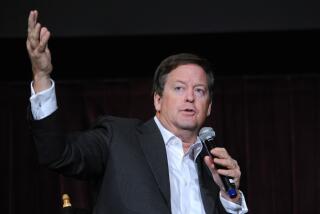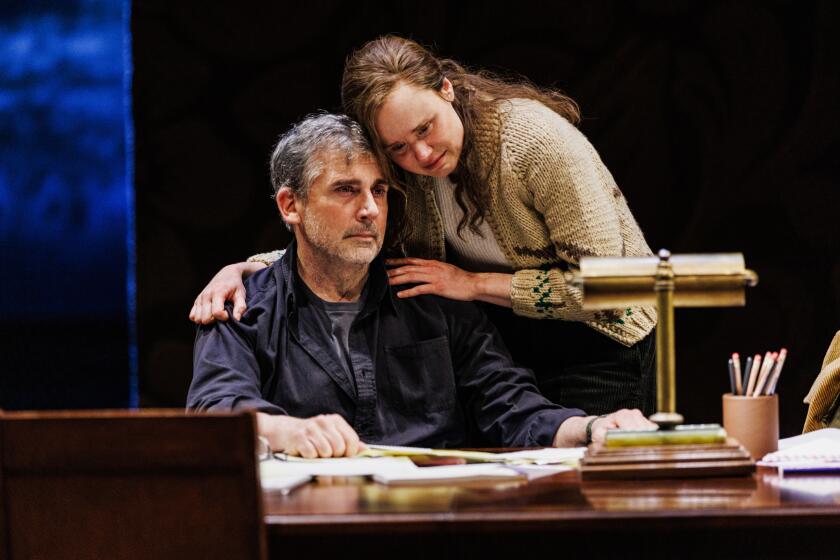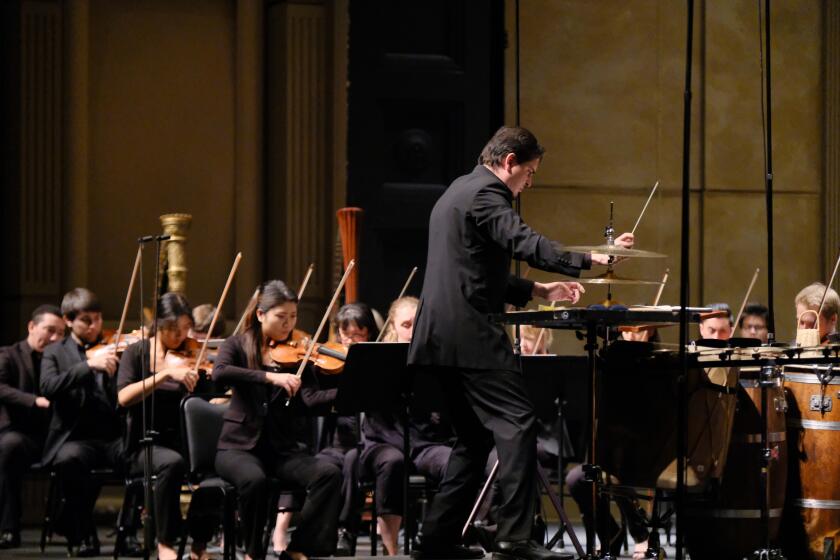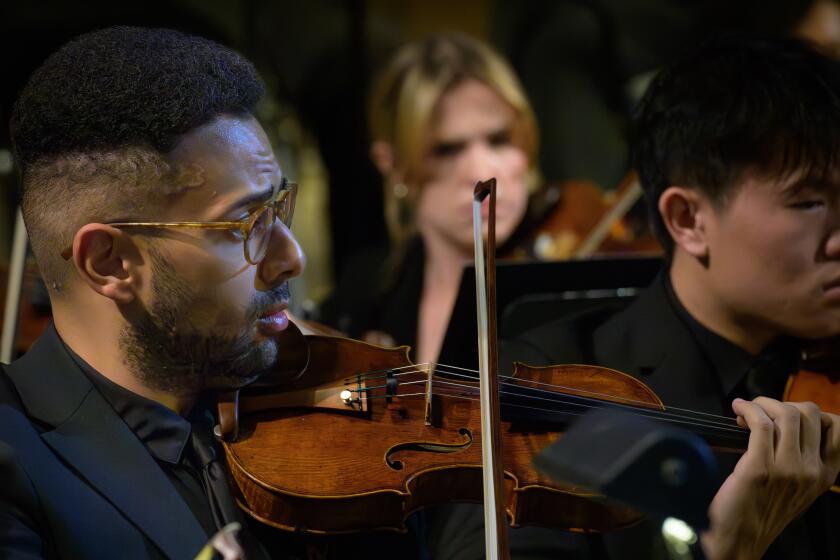Mix and match photographs
KINETIC pictures of sweaty club-goers, caught in moments of passion and ecstasy, hang along one wall. A few feet away, a more serene photograph captures a centuries-old statue dedicated to the Christian trinity.
Wolfgang Tillmans, the German-born photographer whose retrospective opens at the Hammer Museum on Sunday, has never hung these pieces quite so close before. For him each show needs to be fitted to the space and city in which it appears; it allows him a fresh chance to make a new kind of statement with the work.
He sees the photographs, however seemingly disparate, as having much to say to each other.
“All this emotion is happening right on the surface, on the skin,” says a bearded, sincere Tillmans, pointing to the pictures from the club Chemistry, shot during London’s techno-mad early ‘90s.
The statue photograph has a clear spiritual side. “But I always saw this ‘Chemistry’ series as deeply spiritual, this longing of these souls for communion, which is essentially a spiritual feeling. It’s actually the one positive thing I find about organized religion.”
Tillmans’ career, which reached a milestone in 2000 when he became the youngest artist and first photographer to win Britain’s Turner Prize, is full of bold contrasts: His key artistic inspirations have been septuagenarian artist Gerhard Richter and Boy George, whose band Culture Club galvanized the artist as a teenager.
He’s famously photographed model Kate Moss but rails against consumerism. “Though I have an interest in pop culture, in the modern world,” he says, “I’m really promoting in my work a marketing-free world.”
Tillmans likes to blur categories, as when he poses the rhetorical question of whether he’s a conceptual artist or a snapshot photographer.
“I’m actually doing both,” he says, with a manner that’s intellectually brash and personally bashful. “I got first known with pictures from the youth culture and portraits with that spontaneity, but formal interest was always there.
“The nature of my work is always to do both. To stage and not to stage. They are friends; they are not my friends. Mundane objects and extremely rarefied objects. But people recognize one thing, and then it sticks to you. And of course the ambiguity is what the world needs. What the world suffers from is too many people thinking in black and white, with false assumptions and false certainties.”
An off-kilter scale
This keeping the viewer off balance is a major part of Tillmans’ artistic mission. Russell Ferguson of the Hammer, who co-curated the show with Dominic Molon of the Museum of Contemporary Art, Chicago, writes in his catalog essay that the artist “has consistently pushed back against whatever perceptions of his work seem most current.”
Another way the artist, who was born near Cologne, Germany, in 1968 and moved to England in 1990 to study art in Bournemouth, defies expectations is by installing each show himself.
The Hammer’s galleries are both smaller than those at Chicago’s Museum of Contemporary Art, the show’s first stop, and differently configured. The rooms prescribe a stricter flow, and the lighting, wall color and ceilings vary.
These issues matter, he says. “The normal understanding of photographs is photographic imagery. We tend to think of them as content” -- as pictures of a house or a person or a field -- “rather than as objects.”
But he’s into the materiality. “I’ve always liked printing them and making them myself.” The way the pieces become tactile, and the way they’re hung, are the last, crucial steps of his artistic process.
“Even though the installation process is a time of great anxiety,” says Tillmans, who stayed up until 2 a.m. some nights, after long days with as many as seven assistants and a boombox full of Cesaria Evora and Joy Division, “it’s also a time of great pleasure and excitement and of play.”
He tends to arrange exhibitions with maximum contrasts of scale, subject matter and tone. At the Hammer, a single gallery has a series of 56 pieces called “Concorde,” each with the famous airplane, on one wall, and a large, almost fairy-tale photograph of two men by a moonlit lake nearby.
Another gallery is lined with photographs of people. “You feel that this is a portrait room,” he says, “but it also has a Shaker tree and a big abstract piece called ‘Urgency,’ also these flowers. So there are actually three key pictures, the biggest in the room, that are not people.”
And the company in which pieces are placed can allow them to be seen with new eyes. The proximity of “Urgency” -- one of several recent organic-looking abstract pieces -- to all of these people brings out its resemblance to skin or internal organs.
And the portrait room does not make up the range of Tillmans’ work -- with subjects in sexual situations, clubbing, engaged in political demonstrations -- but rather what he calls “a contemplative stance of these people resting in themselves, not showing off.”
The show at the Hammer, in fact, is less random and chaotic than most of his exhibitions. Tillmans says he has hung it in a way that’s so traditional it “undermines what some people have come to expect from me.”
Although there are shifts in scale, there are fewer “dense clusters of pictures and aggressive collisions of different subject matter,” he says. Each picture has more space here, in a more orderly grouping.
“In a way this calms things down,” he says. “Chicago was a bit of an explosion of the entire world on the walls. I feel this calmer approach may be better for this hyperactive and lowattention-span city,” he says, apologizing for his conceit. “It’s connected to things I really like about the West Coast, like the contemplation of nature.”
Informing opinions
Ferguson praises the work for its combination of classical beauty and thoughtfulness, compositional rigor and a light touch.
“It’s a good time to have a survey show of Wolfgang’s work in the U.S., because he’s been so influential as an artist,” he says. “But at the same time there’s been so much misunderstanding of his work in this country. People have formed their ideas about his work seeing very small sections of it.”
To his detractors, Tillmans is a fashion photographer punching above his weight. “I have no idea why Tillmans is supposed to be an artist,” critic Mathew Collings wrote in the Observer shortly before the Turner was awarded. “If he wins, the message will be that the Tate ... wants to get down and boogie in an embarrassing way with the youthful airheads who read the Face.”
But Tillmans, who considers his magazine shots of a piece with his own work, sees himself as part of a lineage longer than Kate Moss and Boy George’s Culture Club.
“Photography is only a continuation of sculpture and painting,” he says. “I see myself in the tradition of picture-making. It has nothing to do with what happened 150 years ago; that was just technological change. There was a change with the invention of oil painting as well.
“Art that stays has invented new ways of picture-making,” he says. “If I can invent something once a year, for 50 years, I’m very happy.”
*
Wolfgang Tillmans
Where: UCLA Hammer Museum, 10899 Wilshire Blvd., Los Angeles
When: 11 a.m. to 7 p.m. Tuesdays, Wednesdays, Fridays and Saturdays; 11 a.m. to 9 p.m. Thursdays; 11 a.m. to 5 p.m. Sundays; closed Mondays
Dates: Sept. 17 through Jan. 7
Price: $3 to $5
Contact: (310) 443-7000; www.hammer.ucla.edu
More to Read
The biggest entertainment stories
Get our big stories about Hollywood, film, television, music, arts, culture and more right in your inbox as soon as they publish.
You may occasionally receive promotional content from the Los Angeles Times.






